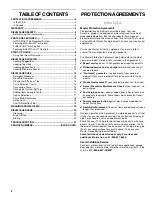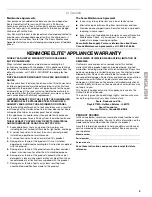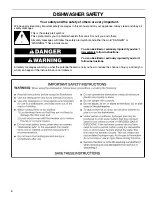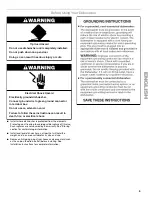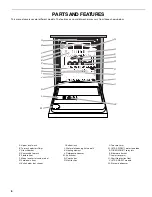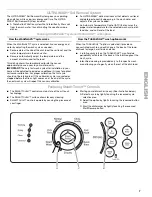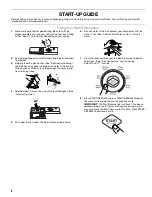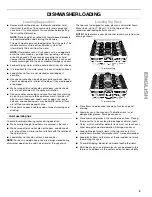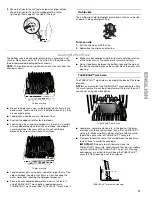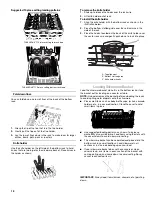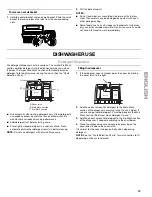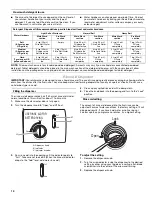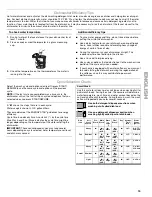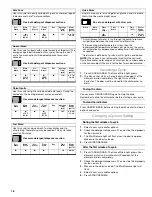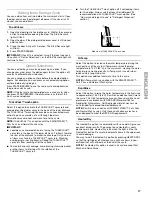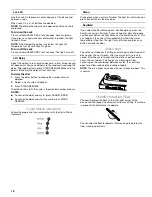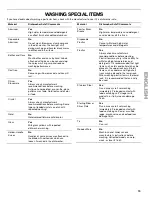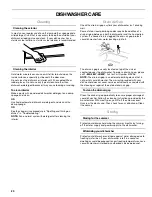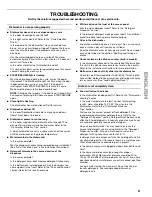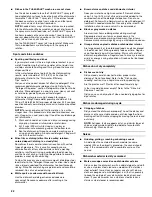
15
Dishwasher Efficiency Tips
Hot water dissolves and activates the dishwashing detergent. Hot water also dissolves grease on dishes and helps glasses dry spot-
free. For best dishwashing results, water should be 120°F (49°C) as it enters the dishwasher. Loads may not wash as well if the water
temperature is too low. Water that is too hot can make some soils harder to remove and cause certain detergent ingredients not to
function. If your water heater is located far from the dishwasher, it may be necessary to run the hot water at the faucet closest to the
dishwasher to minimize the amount of cold water in the water line.
To check water temperature
1. Run hot water at the faucet closest to your dishwasher for at
least 1 minute.
2. Place a candy or meat thermometer in a glass measuring
cup.
3. Check the temperature on the thermometer as the water is
running into the cup.
Additional efficiency tips
■
To save water, energy and time, do not rinse dishes before
putting them into the dishwasher.
■
Use a delay feature to run your dishwasher during off-peak
hours. Local utilities recommend avoiding heavy usage of
energy at certain times of day.
■
During the summer, run your dishwasher at night. This
reduces daytime heat buildup in the kitchen.
■
Use a rinse aid to improve drying.
■
Use cycles or options that add extra heat to the wash or rinse
portion of the cycle only when needed.
■
If your home is equipped with a water softener, you may want
to avoid starting the dishwasher during the regeneration of
the softener, since this may contribute to poor wash
performance.
Cycle Selection Charts
Select the wash cycle and options desired. Or press START/
RESUME to use the same cycle and options as the previous
cycle.
NOTE: If the last cycle you completed was a rinse cycle, the
dishwasher will run the last full wash cycle and options that you
selected when you press START/RESUME.
A “
●
” shows the steps that are in each cycle.
Water usage is shown in U.S. gallons/liters.
These models meet the ENERGY STAR
®
guidelines for energy
efficiency.
Cycle time includes dry time. An asterisk ( * ) by the cycle time,
Main Wash, and Final Rinse indicates the cycle time might be
longer depending on the temperature of the water entering the
dishwasher.
IMPORTANT: These sensor-based cycles may take several
hours depending on cycle selected, water temperature, soil level,
and dish mass sensed.
Smart Wash
Use this cycle for all day-to-day soil types when washing full to
partial dish loads. During the cycle, the sensors will determine
water temperature, wash time, and water amount based on the
soil level and the dish load size. During the main wash, the wash
action will repeatedly pause for several seconds.
Use both detergent dispenser sections when
washing a full soiled dish load.
Use one detergent dispenser section when
washing lightly soiled, partial dish loads.
Dish
load
Soil
Level
Sensed
Pre-
Wash
Main
Wash*
Rinse
or
Purge
†
Final
Rinse*
Dry
Average
Time*
(min)
Water
Usage
(gal/L)
Full
Heavy
●
●
145ºF
(63ºC)
●
Rinse
●
140ºF
(60ºC)
●
145*
6.6-7.5/
25.0-28.4
Nominal
●
●
119ºF
(48ºC)
●
Purge
●
140ºF
(60ºC)
●
115*
5.6/21.2
Light
●
115ºF
(46ºC)
●
Purge
●
140ºF
(60ºC)
●
105*
4.3/16.3
Partial
Heavy
●
●
145ºF
(63ºC)
●
Purge
●
140ºF
(60ºC)
●
130*
5.6-6.5/
21.2-24.6
Nominal
●
●
119ºF
(48ºC)
●
Purge
●
140ºF
(60ºC)
●
105*
5.6/21.2
Light
●
115ºF
(46ºC)
●
Purge
●
140ºF
(60ºC)
●
105*
4.3/16.3
Summary of Contents for 665.1378
Page 23: ...23 Notes ...


